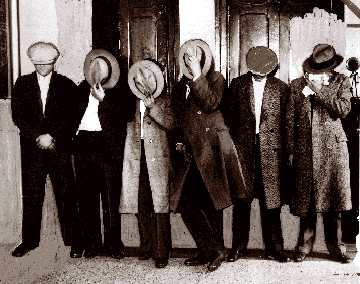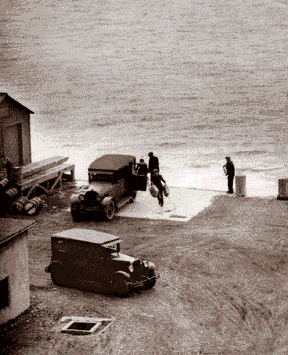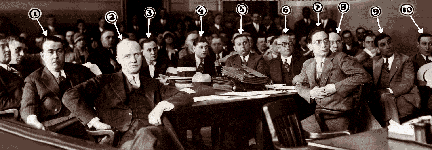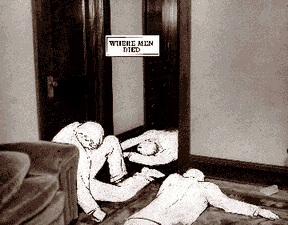Detroit's Infamous Purple Gang

By Paul R. Kavieff
(Condensed by the author from "Off Color," a history of the Purple Gang, by Paul Kavieff)
Detroit's lower east side was a breeding ground for poverty, crime, and violence during the early part of the century. It was in the chaotic streets of this ethnic melting pot that the Purple Gang was born in the years just preceding World War I. Rumor had it that the gang received its colorful name as the result of a conversation between two Hastings Street shopkeepers of the era. Both of the men's shops had been the target of the youngsters' shoplifting and vandalism forays. One day in disgust one of the shopkeepers exclaimed, "These boys are not like other children of their age, they're tainted, off color." "Yes," replied the other shopkeeper. "They're rotten, purple like the color of bad meat, they're a Purple Gang." Most of the young Purples were the children of recently immigrated Russian Jewish parents who worked hard to scrape out an honest living for themselves and their families.

With the advent of Prohibition in Michigan on May 1, 1918, the young delinquents quickly graduated from nuisance types of street crime to armed robbery, hijacking, extortion, and other strong arm work. They became notorious for their high profile manner of operation and their savagery in dealing with enemies.
The four Bernstein brothers, Abe, Joe, Raymond, and Isadore (Izzy), soon became the recognized leaders of the mob. The Purple Gang was never a tightly organized criminal syndicate but a loose confederation of predominantly Jewish gangsters. By the early twenties, the Purples had developed an unsavory reputation as hijackers, stealing liquor loads from older and more established gangs of rumrunners. The Purple Gang always preferred hijacking to rumrunning and their methods were brutal. Anyone landing liquor along the Detroit waterfront had to be armed and prepared to fight to the death as it was common practice for the Purples to take a load of liquor and shoot whoever was with it. In the early years, the Purple Gang preyed exclusively on other underworld operators, insulating them from the police.
The young Purple Gangsters came under the tutelage of two older and established Detroit mobsters in the early twenties named Charles Leiter and Henry Shorr. These two men operated a legitimate corn sugar outlet on Oakland Avenue known as the "Oakland Sugar House." Leiter and Shorr became the mentors of the Purples using the younger men for strong arm work, extortion of local businesses, and to muscle in on the alley brewers to whom they sold bootleg supplies. As a result, the Oakland Sugar House Gang was born, in reality only an early phase of the Purple Gang's evolution.
With their numbers swelled by the influx of mobsters from other cities who came to Detroit to cash in on the golden harvest of Prohibition, the Purple Gang prospered. The mob soon branched out into other rackets. During a period of strife in the Detroit area cleaning industry, the Purple Gang was used as terrorists by corrupt labor leaders to keep union members in line and to harass non-union independents. This conflict became known as the Cleaners and Dyers War. Bombings, thefts, beatings, and murder were all methods employed by the Purples to enforce union policy. They were paid handsomely for their services. The labor war ended with the Purple Gang Trial of 1928 in which all of the Purple Gangster defendants were eventually acquitted. The gang emerged from the trial unscathed and became the dominant power in the Detroit underworld. The Purples ruled the Detroit underworld for approximately five years from 1927 to 1932.

The gang rose to underworld prominence rapidly after a machine gun massacre at the Milaflores Apartments in March of 1927. Three imported gunmen suspected of killing a Purple Gang liquor distributor were butchered in the ambush. Fred "Killer" Burke, famous for his role in the St. Valentine's Day Massacre in Chicago in 1929, was hired by the Purples as the machine gunner. Two other notorious Purple Gang gunmen also participated.
During the late twenties, the Purple Gang reigned supreme over the Detroit underworld, controlling the city's vice, gambling, liquor, and drug trade. They also controlled the local wire service which provided horse racing information to all of the Detroit horse betting parlors and handbooks. The gang even became the suppliers of Canadian whiskey to the Capone organization in Chicago. This arrangement was made after Capone was told by the Detroit underworld to keep his operation out of the city. Capone thought it more prudent to make the Purples his liquor agents rather than go to war with the gang.
For several years the Purples enjoyed almost complete immunity from police interference as witnesses to crimes were terrified of testifying against any criminal identified as a Purple Gangster. Jealousies, egos, and inter-gang quarrels would eventually cause the Purple Gang to self-destruct.

In 1931 an inter-gang dispute ended in the murder of three Purples by members of their own gang. The three men had violated underworld code by operating outside the territory allotted to them by the Purple Gang leadership. Three members of the "Little Jewish Navy," a group of Purples who owned several boats and participated in rumrunning as well as hijacking, decided they would break away from the gang and become an underworld power themselves. The three men, Hymie Paul, Isadore Sutker aka Joe Sutker, and Joe Lebowitz, were lured to an apartment on Collingwood Avenue on September 16, 1931. They believed they were going to a peace conference with Purple Gang leaders. In reality, they were only going to their deaths. After a brief discussion, the three unarmed Purples were shot to death by the Purple Gangsters they had gone to meet. A bookie named Sol Levine, who had transported the three men to the fatal rendezvous, was arrested soon afterwards and was quickly frightened into becoming a State's witness. Levine had been allowed to live because he was a friend of Ray Bernstein. The State had a live witness to the murders and Levine's testimony was devastating. Three of the four Purples involved in the incident which became known as the Collingwood Manor Massacre were quickly arrested. Irving Milberg, Harry Keywell, and Raymond Bernstein, three high ranking Purples, were convicted of first degree murder in the Collingwood Manor Massacre and sent to prison for life.
Although the Purples remained a power in the Detroit underworld until 1935, long prison sentences and inter-gang sniping eventually destroyed the gang's manpower. The predecessors of Detroit's modern day Mafia family simply stepped in and filled the void once the Purple Gang self-destructed.
